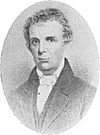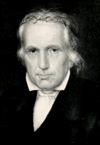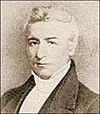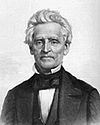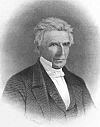Christian Church (Disciples of Christ) facts for kids
Quick facts for kids Christian Church (Disciples of Christ) |
|
|---|---|
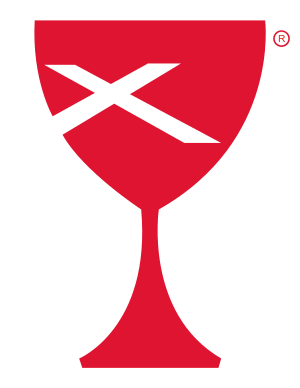
The church's logo shows a chalice with the Cross of St. Andrew.
|
|
| Classification | Protestant |
| Orientation | Mainline Protestant, Restorationist |
| Polity | Congregationalist |
| General Minister and President |
Teresa Hord Owens |
| Associations |
|
| Full Communion |
|
| Region | United States and Canada |
| Headquarters | Indianapolis, Indiana |
| Founder |
|
| Origin |
|
| Separated from |
|
| Congregations | 3,624 |
| Members | 277,864 (2022) |
The Christian Church (Disciples of Christ) is a mainline Protestant Christian group in the United States and Canada. It is often called Disciples of Christ or simply Disciples. The church began during the Second Great Awakening in the 1800s. It started as a group of churches that wanted to bring all Christians together.
Over time, these churches created missionary groups and held conventions. In 1968, the Disciples of Christ officially became a structured denomination. This means it became a more formally organized religious group. When this happened, some churches left because they wanted to remain independent.
The Disciples of Christ was one of the first members of the World Council of Churches (WCC) and the National Council of Churches. The church continues to work with other Christian groups.
Each local church, called a congregation, governs itself. In 2022, the denomination had 277,864 members in the United States and Canada.
Contents
History of the Disciples of Christ
The Christian Church (Disciples of Christ) grew out of the Stone-Campbell Movement in the early 1800s. This movement started with two separate groups that had similar ideas. Both groups came from the Presbyterian Church but didn't know about each other at first.
One group was led by Barton W. Stone in Kentucky. The other was led by Thomas Campbell and his son, Alexander Campbell, in Pennsylvania and Virginia. They wanted to leave behind the different names for church groups and just use names from the Bible for followers of Jesus.
The Stone Movement
In 1801, a large religious gathering called the Cane Ridge Revival took place in Kentucky. This event inspired a new movement. In 1803, Barton W. Stone and others left the Presbyterian Church. They formed a new group called the Springfield Presbytery.
A key moment was in 1804 when they published a document called the Last Will and Testament of the Springfield Presbytery. In it, Stone and his friends announced they were leaving Presbyterianism. They wanted to be part of one single body of Christians. They called for unity, self-governing churches, and using the Bible as their main guide. Soon after, they started calling themselves simply "Christians."
The Campbell Movement
At the same time, Thomas Campbell was leading a similar movement. In 1809, he published the Declaration and Address. In this document, he wrote about his ideas for the church. He focused on Christian unity and returning to the practices of the early church described in the New Testament.
His son, Alexander Campbell, also became a leader in the movement. After studying the New Testament, they began to practice baptism by dipping a person completely in water. This is called immersion. Because of this, they joined a Baptist association for a while. However, their ideas were different from traditional Baptists. Alexander Campbell started a journal called The Christian Baptist to promote his ideas for reform. This led to disagreements, and the Campbells and their followers eventually left the Baptists.
The Two Groups Unite
The two groups, one led by Stone and the other by the Campbells, decided to join together. On December 31, 1831, they met in Lexington, Kentucky. Barton W. Stone and "Raccoon" John Smith (representing the Campbells) shook hands to show their unity. This merger was a success, and the new, larger movement grew.
The new group had trouble deciding on a name. Stone's followers wanted to be called "Christians." Alexander Campbell wanted the name "Disciples of Christ." In the end, both names were used, and they are still used today.
Growth and Division
In 1849, the movement held its first national meeting in Cincinnati, Ohio. They created the American Christian Missionary Society to help spread their message. This was the first of several missionary groups they formed.
However, not everyone agreed with having these organized societies. Some believed that the Bible did not allow for them. This disagreement, along with different views on using musical instruments in worship, led to a split. In 1906, the Churches of Christ officially became a separate group. They did not use musical instruments in their services.
Becoming a Denomination
The churches that stayed together were known as "the Brotherhood." They worked together through missionary societies and conventions. In 1917, they became the International Convention of Christian Churches to include churches in Canada.
After World War II, the leaders felt the church needed a better structure. In 1968, they adopted a new plan called The Design. This officially made the Christian Church (Disciples of Christ) a denomination. This change caused another split. Churches that wanted to remain independent left and became known as the Christian churches and churches of Christ.
The Church Logo
In 1971, the church adopted its official logo. It is a red cup, or chalice, with a white X-shaped cross on it. The chalice represents the Lord's Supper, an important practice for Disciples. The cross is the cross of St. Andrew, which honors the church's Scottish roots.
Beliefs and Practices
Each Disciples church decides how it will worship and serve its community. The church believes in the priesthood of all believers, which means all members are encouraged to interpret the Bible for themselves. The only requirements are to believe in Jesus Christ as Lord and to be baptized.
Core Beliefs
An early slogan of the movement was, "In essentials, Unity; In non-essentials, Liberty; and in all things, Charity." For Disciples today, the main "essential" is accepting Jesus. Beyond that, members have the freedom to hold different beliefs.
Disciples do not use creeds (formal statements of belief) as tests of faith. They respect historical creeds but do not require members to agree with them. This freedom means you can find people with a wide range of views within the same church.
Worship and Communion
A typical Disciples worship service includes singing hymns, Bible readings, and a sermon. Most Disciples churches celebrate the Lord's Supper (also called Communion) every week.
Communion is a time to remember the life, death, and resurrection of Jesus. The Disciples practice open communion, which means all Christians are welcome to take part, no matter which church they belong to.
Baptism
Most Disciples churches practice believer's baptism by immersion. This means that a person who is old enough to believe in Jesus is fully dipped in water. They believe this was the way baptism was done in the New Testament. However, the church also accepts people who were baptized in other ways, including as infants.
Working with Other Churches
The Disciples of Christ strongly believes in working with other Christian denominations. This is called ecumenism. They were founding members of the National Council of Churches and the World Council of Churches.
The church has special partnerships with the United Church of Christ and the United Church of Canada. This means they recognize each other's ministers and sacraments. They also share a global ministry program with the United Church of Christ, called Global Ministries.
How the Church Is Structured
The Disciples of Christ has a unique structure with three main parts, or "expressions": congregational, regional, and general. Each part governs itself but works together with the others.
- Congregations: These are the local churches. Each congregation is self-governing. It hires its own ministers, chooses its leaders, and manages its own buildings and finances.
- Regions: The church is divided into 31 regions, mostly based on state lines. Regions support local churches, help them find ministers, and oversee the training and ordination of new ministers.
- General Church: This is the national and international level of the church. It includes several ministries that focus on specific tasks, like publishing books, managing pensions, and coordinating disaster relief. The whole church meets every two years at a General Assembly. The leader of the general church is the General Minister and President.
Famous Members
Many well-known people have been members of the Christian Church (Disciples of Christ).
- James A. Garfield, the 20th President of the United States.
- Lyndon Baines Johnson, the 36th President of the United States.
- Ronald Reagan, the 40th President of the United States, was baptized in the church as a child.
- J. William Fulbright, a U.S. Senator from Arkansas.
- Colonel Harlan Sanders, the founder of Kentucky Fried Chicken.
- John Muir, a famous environmentalist, was raised in the church.
- Frances McDormand, an award-winning actress.
- John Wooden, a legendary college basketball coach.
Images for kids
See also
 In Spanish: Iglesia Cristiana (Discípulos de Cristo) para niños
In Spanish: Iglesia Cristiana (Discípulos de Cristo) para niños
- First Christian Church, a common name for Disciples congregations
- National City Christian Church, the main Disciples church in Washington, D.C.
- Restoration Movement
- Churches of Christ
- Christian churches and churches of Christ


